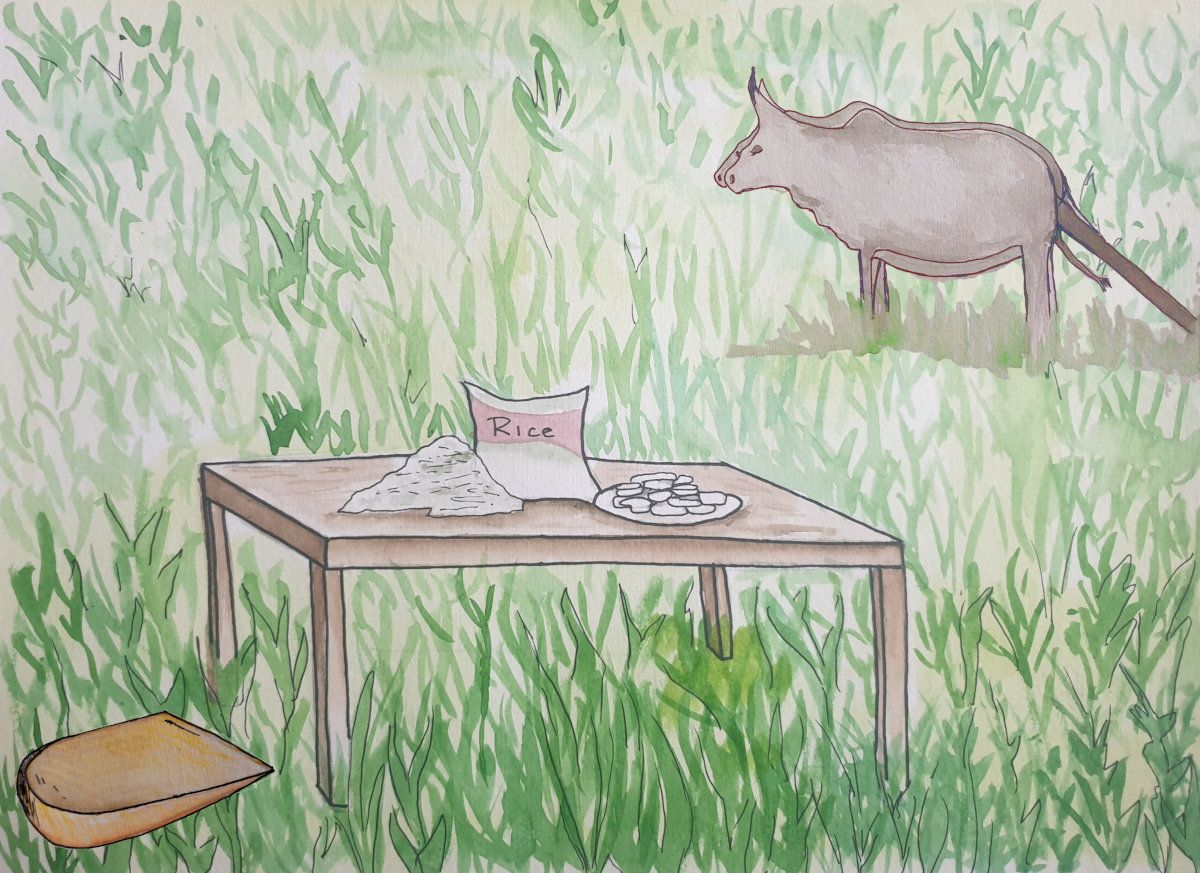From Paddy to Platter
More than half the people on this planet eat rice. But do you know the process by which it’s grown?

More than half the people on this planet eat rice. But do you know the process by which it’s grown?
During my childhood, the day used to start with a freshly brewed Coorg coffee, locally produced. We would sit in the portico enjoying the first rays of the sun amidst the mists of Coorg, with the hot coffee cups in hand and conversing with our pets.
This was followed by a breakfast which I would like to call a ‘rich breakfast’: always made with rice, but what variety of rice preparation there was! Sometimes we’d have akki roti, a kind of flattened rice bread patted down by hand and heated on a stove. Other days it could be kadambuttu rice dumplings, or paaputtu which is made of rice rava and steam-cooked in a mixture of coconut and milk.
Memories of eating and growing rice are still etched in my mind, as growing rice was much associated with family. Today, I am going to take you to a place called Coorg or Kodagu, in the southern part of India, to explore how rice is cultivated.
Rice is probably the single most important food crop in the world. It is the staple diet for more than 3.5 billion people, of the 7.9-billion-odd humans on this planet. Or, to put it another way, if you take two random people, chances are one of them would be a rice-eater. It’s no surprise then, that the word for “rice” is a synonym for food in many places.
The Japanese say ‘gohan’ for rice, but ‘asa-gohan’, ‘hiru-gohan’ and ‘ban-gohan’ for breakfast, lunch, and dinner respectively. Closer to home, the colloquial Tamil word for rice, 'saapad', is used for general food too.
The consensus has always been that rice arose about 30 million years ago in China, although some evidence has cast doubt on that claim. In 2011, scientists found fossilised remains of dinosaur dung in Maharashtra, India, containing traces of the early predecessor to rice. Whichever way it was, the earliest records of domesticated rice come from China, from where it must have spread until it covered most of the continent.
Most rice is grown during the monsoon season, when rains provide it with the water it needs to grow.
When one thinks of rice fields, one usually thinks of large fields flooded with water, the rice plants sticking up from it in a grasslike carpet. There are also varieties of rice that grow on the dryland, which can survive without much water for most of the year—but it still helps to start in the monsoon and give them a boost.
In some places, such as Japan, rice cultivation is very much dependent on water. Here, people have been growing rice in the same pattern for so long that the local wildlife has incorporated the paddy cycle into the ecosystem. Catfish, for example, wait till the annual flooding of rice fields to breed their young; a process which ends before the fields are drained out nearer to harvest time.
Before planting rice, one needs to prepare the field by ploughing or tilling. This turns the soil over, meaning the nutrients present in the lower layers get pushed to the top where the plants can make use of it to grow.
As a bonus, the soil is now loose, as furrows are formed, and also more fertile because it can hold more water.
The traditional way to run a plough is to have it run by two bulls or oxen. Imagine a long, horizontal piece of wood placed across the backs of two bulls, connecting them together. The plough hangs down from the middle of the wooden piece, forming a ‘T’ of sorts. The plough has a curved iron attachment at the end, which is called the ‘ploughshare’. This is the part that does all the digging!
Behind the bulls walks the farmer, walking in excruciatingly small circles around the vast field under the blazing sun...or so it seems, but there is of course also the moist wet mud cooling his feet. It is a slow manual process, which can sometimes be tedious sometimes but also relaxing.
Ploughing often takes up the majority of the day. In modern times, this work can be done in a jiffy. Tractors and tillers finish ploughing a field in just a few hours! Once ploughed, the seasonal rains act as a catalyst to moisten the soil, making the field ready for sowing.
What we call “rice” is the white grains you normally get at a store, but what is sown is something more. It includes the outer husk, as well as the nutritious brown layer which sadly gets polished away while grinding. These full grains-with-husk are what are known as “paddy”.
Don’t think there’s just one paddy though: humans have been cultivating rice for generations, and have come up with different sets of seeds for different conditions. You can get short-duration seeds that grow in a matter of months, medium-duration and long-duration versions that take a bit more time but work with fewer resources. There are drought-resistant varieties that end up giving you a bit less rice than usual—but that’s still much more than you’d get by planting ordinary rice and having it dry up.
There are rice varieties that grow on the highland, clinging tightly to the sloping soil so as not to be washed away; there are lowland varieties that work better in the plains. Rice varieties also vary based on the type of soil and other climatic conditions, so as you can see there’s a lot to choose from!
In hilly areas like Coorg, the variety called ‘Intan’ works the best: it’s a long-duration variety grown during the rainy season.
Now that we have the field ready, it’s time to plant! The traditional way was to broadcast over the field by hand: this means walking along the field with a basket of seeds, swinging your arm for maximum coverage as you throw them from your hand. Once that’s done, there’s no going back: the plants grow where the seeds land.
Today, we have a new two-step process to grow the rice more evenly. The new method has its roots in Japan, and it goes something like this:
First, plant the paddy on a nursery bed—a pseudo-field of sorts—for a few weeks. Once ready, the paddy saplings are uprooted and tied in bunches, to be replanted in rows on the final field.
Since we have sapling bunches to work with, we can make sure we plant them evenly, leaving a good amount of space between them. This space is usually the open palm of one hand, and it leaves a gap to easily remove weeds or apply manure to the plants later on.
Very modern farms today perform direct sowing through a drum roller machine: the seeds are sown in rows, directly through the machine, without any sprouting step in the middle but still with a neat result.
Two or three months after planting, the plants will have matured, and you’ll see the new paddy on the stalks of the plant. That’s when the harvesting begins.
Harvesting—the actual cutting of the plants—happens with a sickle or with modern machinery. But that’s only the first part of the process. Once harvested, rice seeds or paddy have to be separated from the rest of the plant.
This involves beating a sheaf with a stick, or beating the sheaf upon the ground to loosen the grains. But once loose, they have to be shaken off—and that’s where the bullocks come in again! During the harvest season, it was common to see bullocks walking around in small circles over golden sheaves, their heavy bodies working to shake the grains off.
Nowadays, since there are fewer bullocks around, it’s tractors that often run over the sheaves to dislodge them.
Playing on those loosened and spread sheaves by jumping on them make up some of my most cherished childhood memories. Finally, the loosened sheaves would be collected—and what remained on the ground was paddy.
What about the rest of the plant, which the paddy was shaken off from? In case you haven’t figured it out yet: that’s what would end up as hay.
The final step in this process was winnowing. This involves throwing the grains into the air with a gentle tossing motion (like a chef tossing vegetables) and allowing the wind or air to blow away impurities—think husk!
Winnowing is usually done using special woven trays made from bamboo known locally as ‘mora’. These are shaped something like a handle-less dustpan but much larger. Alternatively, dried grains are made to fall from a height using shovels and a sieve. The grains fall vertically while the weightless chaff and straw get blown away by the wind. (Modern winnowing machines speed up the process, but they do essentially the same thing).
Now you’ve got the fine rice grains which are usually further polished, but these rice grains are now ready to cook and prepare in your platter along with other side dishes.
Here’s to another rich breakfast!
